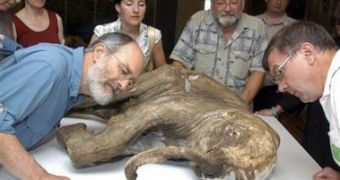It lacks only hair. As for the rest, it looks like it died yesterday. The recent finding in May 2007 of a baby mammoth preserved in the Russian permafrost offers the best chance so far to build a genetic map of the Ice Age extinct species.
"It's a lovely little baby mammoth indeed, found in perfect condition," said Alexei Tikhonov, deputy director of the Russian Academy of Science's Zoological Institute.
"This specimen may provide unique material allowing us to ultimately decipher the genetic makeup of the mammoth," he told Reuters.
The specimen is a 6 months old female, called "Lyuba" after the wife of reindeer breeder and hunter Yuri Khudi who discovered her in Russia's Arctic Yamalo-Nenetsk region.
"She had been lying in the frozen ground for up to 40,000 years", said Tikhonov.
The hunter initially believed the mammoth was the corpse of a reindeer when he spotted parts of her body sticking out of damp snow. Scientists were called when he realized it was a mammoth and the body was transported to the regional capital Salekhard, where it is now being kept in a special refrigerator. Lyuba is weighing 50 kg (110 lb) and she is 85 cm tall and 130 cm from trunk to tail, about the size of a large dog.
"The fact the mammoth is so remarkably well-preserved -- its shaggy coat is gone but otherwise it looks as though it has only recently died -- means it is a potential treasure trove for scientists. Such a unique skin condition protects all the internal organs from modern microbes and micro-organisms ... In terms of its future genetic, molecular and microbiological studies, this is just an unprecedented specimen." said Tikhonov.
But he does not believe this mammoth could be cloned to deliver a live mammoth.
"Cloning can only be done if whole cells are intact, but the freezing conditions will have caused the cells to burst," said Tikhonov.
Lyuba will go to the Zoological Museum of St Petersburg, joining a male baby mammoth named Dima, discovered in Magadan in Russia's Far East in 1977. Dima was until now Russia's best-known mammoth specimen.
"They will make a nice couple, both roughly aged 40,000 years," Tikhonov said.
From St Petersburg, Lyuba will travel to Jikei University in Japan to undergo three-dimensional computer analysis of her body and will return to St Petersburg for an autopsy before being exhibited in Salekhard.

 14 DAY TRIAL //
14 DAY TRIAL //